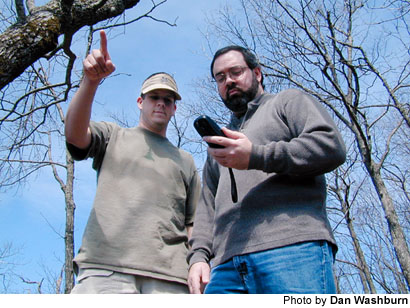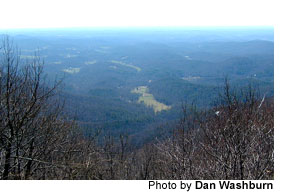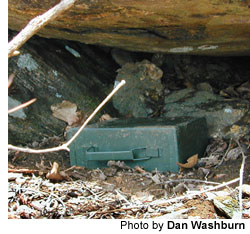
March 20, 2001 — The Appalachian Trail was crowded on Saturday.
Skies were clear for a change, and warm winter temperatures made a trip to the North Georgia mountains a must. There were hordes of hikers — but I’m fairly certain Shane Adams, Jason Long and I were the only ones on a hunt for hidden treasure.
We were Geocaching (pronounced geo-cashing), a form of high-tech hide-and-seek, and our prize was positioned somewhere atop Ramrock Mountain, 3,200-feet tall and a 1.25-mile hike from the Woody Gap picnic area off of Ga. 60 near Suches.
 “It’s modern-day treasure hunting,” Long, 25, of Baldwin, said with a smile as we gathered in the parking lot.
“It’s modern-day treasure hunting,” Long, 25, of Baldwin, said with a smile as we gathered in the parking lot.
And in the 21st century, tattered treasure maps are traded in for mini computer screens. Adams, 31, of Turnerville, was busy plugging the hidden cache’s location into his hand-held global positioning system (GPS) receiver.
The latitudinal and longitudinal coordinates of the Ramrock Mountain cache — as well as hundreds of other hidden stashes throughout the world — can be found at www.geocaching.com, the hub for all things Geocaching.
Anyone can hunt for a cache. Anyone can hide one, too. All you need is an adventurous spirit and a GPS device, which can cost $100 or $1,000 depending on the features you desire.
Now, a little bit about the GPS itself. The GPS is a satellite-based navigation network that allows users of GPS receivers to pinpoint their exact location anywhere in the world. The GPS consists of 24 2,000-pound satellites, situated more than 12,000 miles in space, that constantly orbit the Earth.
Until May 1, 2000, the U.S. government — in the interest of national security — intentionally degraded GPS signals available to the public. This process, known as “selective availability,” was discontinued by the Clinton administration, which decided the benefits of the GPS greatly outweighed any risks.
Now GPS users enjoy signals 10 times more accurate than those received during selective availability. Now road, water, air and trail navigation is more reliable.
Now a sport like Geocaching is possible.
On May 3 of last year — just two days after selective availability was discontinued — the first cache was stashed in Portland, Ore. Three days later, it was visited twice. And Geocaching was born.
Now caches can be found in all 50 states. There are 33 in Georgia alone. Not bad for a sport just 11 months old.
“We’re going to let you lead from here,” Adams said as he handed me his GPS unit halfway into our hike.
On the screen, the cache coordinates were marked by a square. An arrow showed our location. As long as the two continued to move closer, I knew we were headed in the right direction.
Adams and Long are veteran Geocachers — which means that they’ve actually done it. Adams, a self-proclaimed gadget-guy, purchased his GPS unit last June “to play with.” Then he started searching the Internet for things he could actually do with it.
Geocaching caught his eye.
“I wanted to try it from the moment I first saw it,” Adams said. And so he did.
Adams told Long about the sport and they went on their first hunt last summer. The duo, who until recently worked together as design draftsmen, has since hidden caches, as well.
I had never heard of Geocaching until a friend passed along the Web site a couple of weeks ago. I posted a message on the site’s Georgia bulletin board and received several responses. Adams’ was the first.
As we hiked south on the Appalachian Trail, Ramrock Mountain loomed larger and larger to our left. The GPS unit told me we were .28 miles away from our target. The screen read 400 feet before we embarked on the steep climb that led to the top of the mountain.
That number kept falling … until it started to get bigger again right near the summit. The cache was near. So was the view of the valley below known as Walnut Cove. And it’s worth the hike, treasure or no.
 Adams and Long found the Ramrock Mountain cache the previous weekend, so they watched as I wandered. I headed down a leafy embankment. The numbers on my screen started to fall again. Adams and Long followed.
Adams and Long found the Ramrock Mountain cache the previous weekend, so they watched as I wandered. I headed down a leafy embankment. The numbers on my screen started to fall again. Adams and Long followed.
I started down another embankment, steeper and more precarious. I heard Adams and Long stop behind me. That told me I was headed the wrong way.
I turned around. And there it was. Placed under a rocky outcrop, the cache came into focus. I found my treasure … and it looked a lot like an Army green ammunition box.
GPS units still aren’t 100 percent accurate. When I happened upon the Ramrock Mountain cache, Adams’ receiver said I was 50 feet away from our destination coordinates. The uncertainty adds to the adventure.
Some difficult cache locations require rappelling equipment — even scuba gear.
“It’s very exciting,” Adams said. “The hunt is what’s fun for me.”
“Finding the treasure is what’s cool,” Long added. “The goodies are just an extra bonus.”
Oh yeah. The goodies.
Inside the cache were the following odds and ends: A log book (which I signed), a disposable camera (which I used), a Star Glider balsawood airplane, a 4-by-6 picture frame, a CD entitled “Mountain Serenity,” a road atlas, a blank VHS tape, a can coozie, a squirt gun, a calculator, a casino chip from the San Juan Marriott, a Terry Labonte No. 5 Matchbox car, four AA batteries, a Dave & Buster’s power card, a kazoo, a bandana and a key chain that read “Buckle up Alabama. It’s a matter of love.”
I took the batteries and left a deck of playing cards. It’s the Geocaching honor system. You take something; you leave something.
But the fun is free.
